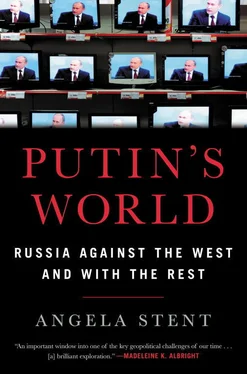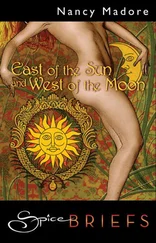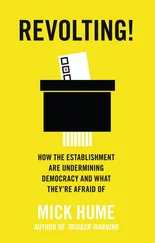Europe as a geopolitical reality has been Russia’s gateway to the achievement of great power status. Russia rose to prominence internationally through the European interstate system, whose rules, by and large, it had to accept and whose development it was able to influence. Russia projected power internationally as a player in the complex and shifting alliances of nineteenth-century Europe. Russia’s engagement with Europe continued during periods of domestic reform and domestic repression. Today Russian officials praise the Concert of Europe, which largely dominated the continent between 1815 and 1914 and in which Russia played an important role. An assassin’s bullet in Sarajevo in June 1914 and the Battle of Tannenberg two months later, when Germany trounced Russia, ended imperial Russia’s European century. The model of great powers dividing the continent, ruling over smaller powers and determining their fate, appeals to Putin. He has explicitly praised the Yalta system, which, of course, remains controversial. For Eastern Europeans, it symbolizes a cynical division of labor in which they lost their independence and came under Soviet domination.
In the nineteenth century, Europe validated Russia’s role as a great power player on the continent. In the twentieth century, the United States was arguably more important in conferring legitimacy on the USSR as the other nuclear superpower. Nevertheless, it was through the Soviet Union’s domination of the eastern half of Europe and its nuclear arsenal that it became a military superpower—though never an economic one. When the Soviet Union lost its Eastern European empire in 1991, its great power status was challenged. Could twenty-first-century Russia remain a great power without dominating half of Europe?
THE SOVIET LEGACY
After the Bolshevik Revolution, the Soviet Union largely retreated from Europe. In the interwar years, it remained on the sidelines of European developments. The USSR’s ties with most European governments were largely strained. The August 1939 Nazi-Soviet Pact, which kept Russia out of the war for two years, enabled Germany and the USSR to march into Poland in September. But it ultimately facilitated the launch of Operation Barbarossa, the German invasion of the Soviet Union, to the shock of Stalin, who had expected the alliance with Germany to last.
At the end of the war, the USSR again became a great power by the division of Europe into two halves and its domination of Eastern Europe, which the Red Army had occupied. Geographically, postwar USSR was the most “European” of any Russian state, reaching as far west as the Elbe River with the Baltic states, Kaliningrad, Moldova, and Eastern Poland part of the newly expanded USSR. But as the USSR became more European territorially, it imposed the Soviet system on Eastern Europe, making that part of Europe less European internally.
Russia’s unprecedented military power and its ability to control Eastern Europe’s fate became the new European reality. While the idea of Europe lived on among the Soviet dissident community, post-1964 Brezhnev-era officials, realizing that the USSR was falling behind technologically, returned to Europe as a model, seeking to import Western technology to substitute for their own lack of innovation. Like previous Russian rulers’ attempts to transplant the European model, this one also failed because the communist leadership’s obsession with political control stifled the free exchange of ideas necessary for true innovation. The need to catch up economically with the West also motivated the Kremlin to seek a political rapprochement with Western Europe and respond to the détente initiatives promoted by West Germany and France. Thus, for the last twenty years of the USSR’s existence, Moscow pursued a two-pronged strategy in Europe: trying to maintain control over an increasingly restive Eastern Europe while pursuing closer ties with Western Europe, hoping to loosen the bonds of the transatlantic alliance.
In 1985, Russia’s attitude toward Europe began to change radically. In the more than three centuries since Russia became a player in the European state system, only one leader has actively engaged all three dimensions of Europe. That was Mikhail Gorbachev. His six years in power saw the resurgence of the idea of Europe inasmuch as his support for glasnost (greater openness) was an appeal to European values. Perestroika—the restructuring and modernization of the economy—reflected the attraction of Europe as a model. And in calling for a “common European home,” Gorbachev pursued a rapprochement with Western Europe, seeking to mitigate the Cold War geopolitical reality of a divided Europe. 6He wanted the Soviet Union to play a different role in Europe and increasingly realized that the ailing Soviet system had much to learn from Western Europe. In his first major speech to the British parliament in December 1984 before he became general secretary, the young, smiling, energetic Politburo member with his stylish wife impressed his audience with his refreshingly conciliatory ideas, so different from those of the grim-faced gerontocracy that had ruled the USSR for the previous decade. The striking refrain of “our common European home” had major and unforeseeable consequences. 7
Gorbachev reversed four decades of Soviet policy toward Europe by loosening control over Eastern Europe and eventually renouncing the Soviet empire there, allowing communism to collapse peacefully. But it remains difficult for many Russians to accept that the Kremlin could willingly have abdicated its great power role in Europe. While the Soviet renunciation of the Eastern European Empire was an unintended consequence of Gorbachev’s policies, the rapprochement with Western Europe that followed was both deliberate and initially successful. A major legacy of the Gorbachev era was Western European gratitude toward Russia for allowing a common European home to rise from the ashes of the moribund communist system. The nations of Eastern Europe were far more ambivalent: relieved that they had finally regained their sovereignty but resentful of four decades of Soviet rule. With the end of the Warsaw Pact military alliance, Moscow’s presence in and influence over the European continent was sharply reduced. Russia’s geographic European reach shrunk to that of the seventeenth century. At the very time when Russians appeared to be most open to European ideas and models of government, Russia had the least influence over Europe than it had had for two centuries. This set the stage for a new Russia-Europe reality.
FROM YELTSIN TO PUTIN: REDISCOVERING EUROPE
During the first years of the Yeltsin presidency, Foreign Minister Andrei Kozyrev was determined that Russia should seek to emulate Europe and its institutions. He and other Yeltsin supporters initially embraced both the idea and model of Europe, wishing to join the major Western clubs, such as the G-7, the World Trade Organization, and the Council of Europe. Meanwhile, relations with Central and Eastern Europe atrophied, as the countries in these regions, plus the Baltic states, also sought to join European institutions as quickly as possible to put more distance between them and Russia. The Kremlin viewed the European Union (EU) and its key members, such as Germany and France, as sources of political and economic support during difficult post-1991 years, and Western Europe was generally eager to participate in the post-communist transition and increase its economic ties with Russia.
Russia’s trade with Europe grew in the 1990s, and Brussels and Moscow signed a Partnership and Cooperation Agreement in 1994, which came into force in 1997. In those days, many believed that increased economic ties would promote better political relations. The agreement with the EU was designed to encourage economic and scientific ties and to facilitate Russia’s integration into European structures. But as the 1990s wore on, Russia’s relations with Europe became increasingly strained by NATO’s campaign to end the wars in Yugoslavia. Whereas Russia cooperated reluctantly with NATO during the Bosnian campaign, the Kosovo campaign and NATO’s bombing of Serbia caused major problems with Europe. Yeltsin’s deteriorating health and erratic behavior, the replacement of pro-European Kozyrev with the more hard-line Yevgeny Primakov, Russia’s economic problems culminating in the ruble crash in 1998, and the increasingly opaque nature of Russian politics and business led to greater European questioning of the direction Russia was taking and whether its evolution was at odds with their original expectations.
Читать дальше












